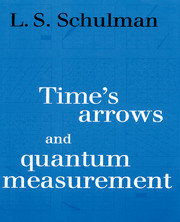Book contents
- Frontmatter
- Contents
- Preface
- 1 Introduction
- 2 Irreversibility
- 3 Arrows of time
- 4 Correlating arrows of time
- 5 Two-time boundary value problems
- 6 Quantum measurements: cats, clouds and everything else
- 7 Existence of special states
- 8 Selection of special states
- 9 Abundance of special states
- 10 Experimental tests
- 11 Conclusions and outlook
- Author index
- Index
5 - Two-time boundary value problems
Published online by Cambridge University Press: 05 August 2012
- Frontmatter
- Contents
- Preface
- 1 Introduction
- 2 Irreversibility
- 3 Arrows of time
- 4 Correlating arrows of time
- 5 Two-time boundary value problems
- 6 Quantum measurements: cats, clouds and everything else
- 7 Existence of special states
- 8 Selection of special states
- 9 Abundance of special states
- 10 Experimental tests
- 11 Conclusions and outlook
- Author index
- Index
Summary
Although the variational principles of classical mechanics lead to two-time boundary value problems, when dealing with the real world everyone knows you should use initial conditions. Not surprisingly, the eighteenth-century statements of classical variational principles were invested with religious notions of teleology: guidance from future paths not taken could only be divine. The Feynman path integral formulation of quantum mechanics makes it less preposterous that a particle can explore non-extremal paths; moreover, it is most naturally formulated using information at two times. In the previous chapter, use of the two-time boundary value problem was proposed as a logical prerequisite for considering arrow-of-time questions. Perhaps this is no less teleological than Maupertuis's principle, except that we remain neutral on how and why those conditions are imposed.
In this chapter we deal with the technical aspects of solving two-time boundary value problems. In classical mechanics you get into rich existence questions—sometimes there is no solution, sometimes many. For stochastic dynamics the formulation is perhaps easiest, which is odd considering that this is the language most suited to irreversible behavior. Our ultimate interest is the quantum two-time problem and this is nearly intractable.
Later in the book I will propose that the universe is most simply described as the solution of a two-time boundary value problem. A natural reaction is to wonder whether this is too constraining. Given that our (lower entropy) past already cuts down the number of possible microstates, are there sufficient microstates to meet a future condition as well?
- Type
- Chapter
- Information
- Time's Arrows and Quantum Measurement , pp. 161 - 194Publisher: Cambridge University PressPrint publication year: 1997



